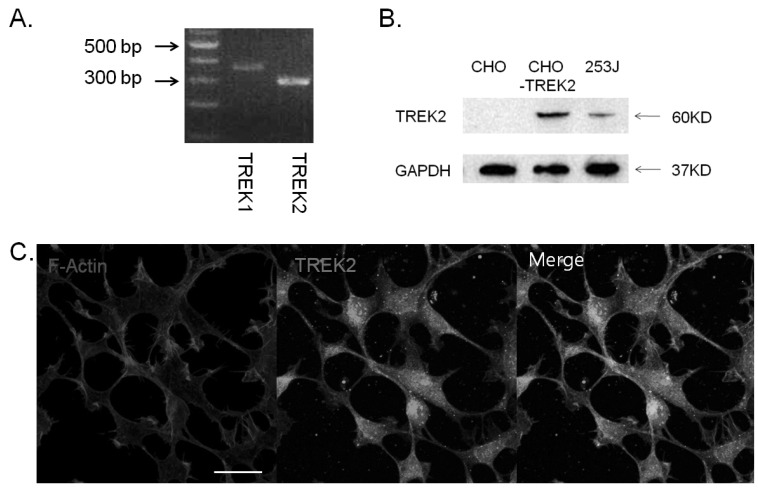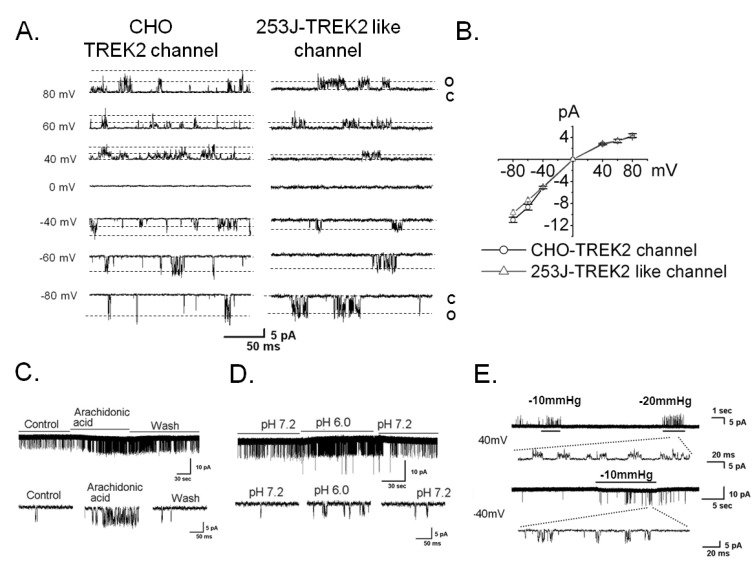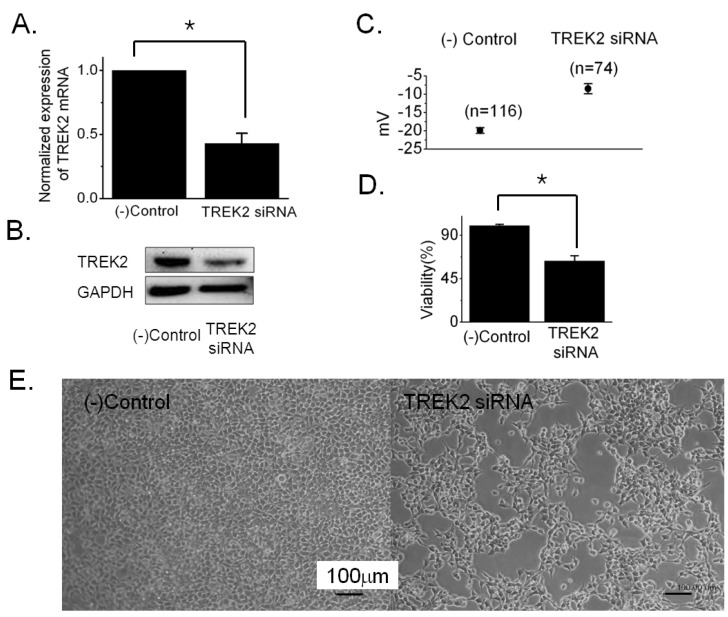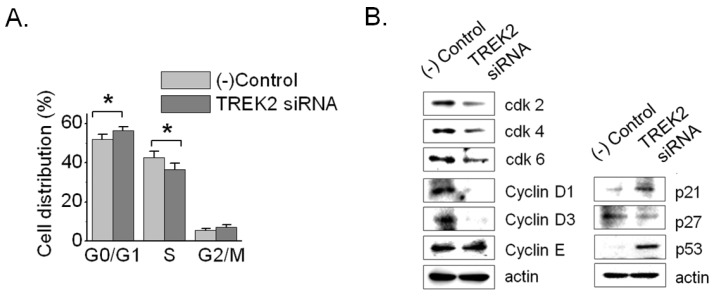1. Becchetti A. Ion channels and transporters in cancer 1 Ion channels and cell proliferation in cancer. Am J Physiol Cell Physiol. 2011; 301:C255–C265. PMID:
21430288.

2. Kunzelmann K. Ion channels and cancer. J Membr Biol. 2005; 205:159–173. PMID:
16362504.

3. Ouadid-Ahidouch H, Ahidouch A. K
+ channel expression in human breast cancer cells: involvement in cell cycle regulation and carcinogenesis. J Membr Biol. 2008; 221:1–6. PMID:
18060344.
4. Li M, Xiong ZG. Ion channels as targets for cancer therapy. Int J Physiol Pathophysiol Pharmacol. 2011; 3:156–166. PMID:
21760973.
5. Es-Salah-Lamoureux Z, Steele DF, Fedida D. Research into the therapeutic roles of two-pore-domain potassium channels. Trends Pharmacol Sci. 2010; 31:587–595. PMID:
20951446.

6. Kim KA, Kim Y. The effect of flavonoids on the TREK-1 channel. J Korea Acad-Ind Coop Soc. 2011; 12:2660–2667.

7. Pei L, Wiser O, Slavin A, Mu D, Powers S, Jan LY, Hoey T. Oncogenic potential of TASK3 (Kcnk9) depends on K
+ channel function. Proc Natl Acad Sci U S A. 2003; 100:7803–7807. PMID:
12782791.
8. Voloshyna I, Besana A, Castillo M, Matos T, Weinstein IB, Mansukhani M, Robinson RB, Cordon-Cardo C, Feinmark SJ. TREK-1 is a novel molecular target in prostate cancer. Cancer Res. 2008; 68:1197–1203. PMID:
18281496.

9. Innamaa A, Jackson L, Asher V, van Schalkwyk G, Warren A, Keightley A, Hay D, Bali A, Sowter H, Khan R. Expression and effects of modulation of the K2P potassium channels TREK-1 (KCNK2) and TREK-2 (KCNK10) in the normal human ovary and epithelial ovarian cancer. Clin Transl Oncol. 2013; 15:910–918. PMID:
23479219.

10. Kakehi Y, Hirao Y, Kim WJ, Ozono S, Masumori N, Miyanaga N, Nasu Y, Yokomizo A. Bladder Cancer Working Group report. Jpn J Clin Oncol. 2010; 40(Suppl 1):i57–i64. PMID:
20870921.

11. Ploeg M, Aben KK, Kiemeney LA. The present and future burden of urinary bladder cancer in the world. World J Urol. 2009; 27:289–293. PMID:
19219610.

12. Kim Y, Kim WJ, Cha EJ. Quercetin-induced growth inhibition in human bladder cancer cells is associated with an increase in Ca
2+-activated K
+ channels. Korean J Physiol Pharmacol. 2011; 15:279–283. PMID:
22128260.
13. Yamada T, Ueda T, Shibata Y, Ikegami Y, Saito M, Ishida Y, Ugawa S, Kohri K, Shimada S. TRPV2 activation induces apoptotic cell death in human T24 bladder cancer cells: a potential therapeutic target for bladder cancer. Urology. 2010; 76:509.e1. 509.e7. PMID:
20546877.

14. Li Q, Wang XH, Yang ZH, Wang HP, Yang ZW, Li SW, Zheng XM. [Induction of cell cycle arrest in bladder cancer RT4 cells by capsaicin]. Zhonghua Yi Xue Za Zhi. 2010; 90:1230–1233. PMID:
20646592.
15. Hamill OP, Marty A, Neher E, Sakmann B, Sigworth FJ. Improved patch-clamp techniques for high-resolution current recording from cells and cell-free membrane patches. Pflugers Arch. 1981; 391:85–100. PMID:
6270629.

16. Bang H, Kim Y, Kim D. TREK-2, a new member of the mechanosensitive tandem-pore K
+ channel family. J Biol Chem. 2000; 275:17412–17419. PMID:
10747911.
17. Rouzaire-Dubois B, Dubois JM. K
+ channel block-induced mammalian neuroblastoma cell swelling: a possible mechanism to influence proliferation. J Physiol. 1998; 510(Pt 1):93–102. PMID:
9625869.
18. Wonderlin WF, Strobl JS. Potassium channels, proliferation and G1 progression. J Membr Biol. 1996; 154:91–107. PMID:
8929284.

19. Ghiani CA, Yuan X, Eisen AM, Knutson PL, DePinho RA, McBain CJ, Gallo V. Voltage-activated K
+ channels and membrane depolarization regulate accumulation of the cyclin-dependent kinase inhibitors p27(Kip1) and p21(CIP1) in glial progenitor cells. J Neurosci. 1999; 19:5380–5392. PMID:
10377348.
20. Woodfork KA, Wonderlin WF, Peterson VA, Strobl JS. Inhibition of ATP-sensitive potassium channels causes reversible cell-cycle arrest of human breast cancer cells in tissue culture. J Cell Physiol. 1995; 162:163–171. PMID:
7822427.

21. Smith GA, Tsui HW, Newell EW, Jiang X, Zhu XP, Tsui FW, Schlichter LC. Functional up-regulation of HERG K
+ channels in neoplastic hematopoietic cells. J Biol Chem. 2002; 277:18528–18534. PMID:
11893742.
22. Wonderlin WF, Woodfork KA, Strobl JS. Changes in membrane potential during the progression of MCF-7 human mammary tumor cells through the cell cycle. J Cell Physiol. 1995; 165:177–185. PMID:
7559799.

23. Ouadid-Ahidouch H, Le Bourhis X, Roudbaraki M, Toillon RA, Delcourt P, Prevarskaya N. Changes in the K
+ current-density of MCF-7 cells during progression through the cell cycle: possible involvement of a h-ether.a-gogo K
+ channel. Receptors Channels. 2001; 7:345–356. PMID:
11697078.
24. Ouadid-Ahidouch H, Roudbaraki M, Delcourt P, Ahidouch A, Joury N, Prevarskaya N. Functional and molecular identification of intermediate-conductance Ca
2+-activated K
+ channels in breast cancer cells: association with cell cycle progression. Am J Physiol Cell Physiol. 2004; 287:C125–C134. PMID:
14985237.
25. Borowiec AS, Hague F, Gouilleux-Gruart V, Lassoued K, Ouadid-Ahidouch H. Regulation of IGF-1-dependent cyclin D1 and E expression by hEag1 channels in MCF-7 cells: the critical role of hEag1 channels in G1 phase progression. Biochim Biophys Acta. 2011; 1813:723–730. PMID:
21315112.

26. Vermeulen K, Van Bockstaele DR, Berneman ZN. The cell cycle: a review of regulation, deregulation and therapeutic targets in cancer. Cell Prolif. 2003; 36:131–149. PMID:
12814430.

27. Park KS, Kim Y. Functional expression of mechanosensitive two-pore domain potassium channel in human bladder carcinoma cells. J Biomed Res. 2013; 14:71–76.

28. Kang D, Kim D. TREK-2 (K2P101) and TRESK (K2P181) are major background K
+ channels in dorsal root ganglion neurons. Am J Physiol Cell Physiol. 2006; 291:C138–C146. PMID:
16495368.
29. Han J, Gnatenco C, Sladek CD, Kim D. Background and tandem-pore potassium channels in magnocellular neurosecretory cells of the rat supraoptic nucleus. J Physiol. 2003; 546:625–639. PMID:
12562991.




